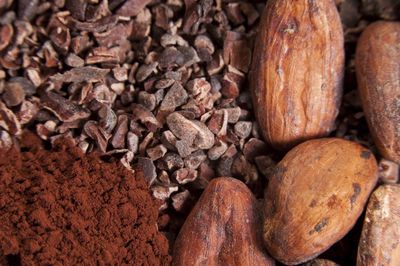Chocolate 101: How to Dominate Your Dessert

The Chocolate Guide: Unsweetened chocolate, cocoa powder, bittersweet/semisweet chocolate and milk chocolate all serve different purposes, with various levels of sweetness and different forms of texture.
In a follow up to my “Cupcakes Sans Frosting? Is that a Crime?” story, I would like to provide some chocolaty tips for buying, using and “manipulating” chocolate to serve your needs.
Unsweetened Chocolate is pure chocolate liquor in the rawest form. It is the basis for all chocolates. Most unsweetened chocolates are starchy and unrefined…not to mention disturbingly bitter (who hasn’t snuck a piece from mom’s kitchen counter only to find out that it’s totally gross???). This type of chocolate is preferred among most dessert makers — it allows the baker to determine the sweetness of the dessert. Bittersweet chocolate is perfect for brownies.
GOOD TO KNOW: This type of chocolate, if stored properly — in a well-wrapped, cool, dry place with good air circulation — can keep for years.
Cocoa Powder is chocolate liquor with most of the fat removed. There are two types of cocoa powder: natural and Dutch. Cocoa powder is perfect for making frosting, hot chocolate, or if you are on the adventurous side, it can be used in chili or stew.

Unsweetened chocolate is pure chocolate liquor in the rawest form. It is the basis for all chocolates.
GOOD TO KNOW: Dutch cocoa is alkalized (removing the natural acidity). Make sure to read your recipe — if it calls for a specific cocoa, make sure to use that specific cocoa. Replacing natural cocoa with Dutch cocoa can cause your dessert to rise unevenly or poorly.
Bittersweet/Semisweet chocolate is made from chocolate liquor and sugar. Bittersweet and semisweet can be used interchangeably. Both of these types of chocolate provide deep rich flavors and have a smooth texture. These types of chocolate are perfect for the classic chocolate chip cookie.
GOOD TO KNOW: If you are using a recipe that calls for semisweet, but all you have on hand is bittersweet, just add a bit more sugar in your recipe.
Milk Chocolate contains milk solids and sugar, in addition to chocolate liquor. When presented with milk chocolate I’ve found it best to scrap the whole baking exercise and proceed to the eating phase of the process. The protein from the milk solids in milk chocolate has a tendency to interfere with the integrity of a dessert rather than enhance it. This type of chocolate is great in something like a toffee bar dessert.
GOOD TO KNOW: Milk chocolate does not age gracefully, so keep in mind that because of all the extra goodness, it will eventually become stale. It is also very heat sensitive — be sure to keep it in a nice cool spot, very well sealed, and the location should have good air circulation. This type of chocolate will keep for less than one year.
OK, so now on to the “oops I don’t have that type of chocolate AND I’m in no mood to drive to the store AND/OR I know that my neighbors don’t have any of what I want” type of moment.
Have you ever found yourself standing in front of your pantry…recipe in hand, ready to start baking away and then you can’t find the “right” chocolate for your recipe? Here are some tips to manipulate chocolate to fit your needs.
1 ounce = 3 tablespoons natural cocoa powder (not Dutch-processed) plus 1 tablespoon unsalted butter, vegetable oil or shortening
1 ounce Dutch-Processed = 3 tablespoons natural unsweetened cocoa powder plus 1/8 teaspoon baking sod
1 ounce Natural Unsweetened = 3 tablespoons Dutch-processed cocoa plus 1/8 teaspoon cream of tartar, lemon juice or white vinegar
Chocolate, Bittersweet or Semi-sweet:
1 ounce = 1/2 ounce unsweetened chocolate plus 4 teaspoons sugar
1 ounce = 1 ounce bittersweet or semi-sweet plus 1 tablespoon granulated white sugar
—Laura San Nicolas, Brand Marketing







Great tips – anything with chocolate is great with me.